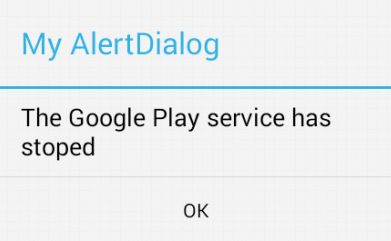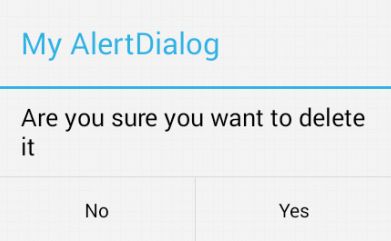AlertDialog基本用法详解
AlertDialog简单介绍:
AlertDialog可以在当前活动界面弹出一个对话框,用于提示一些重要信息或是警告内容。
AlertDialog置于所有页面元素之上,能够屏蔽其他控件的交互。
由于AlertDialog的构造方法被声明为protected,所以我们不能使用new来创建AlertDialog对象。
Android为我们提供另外一个类AlertDialog.Builder,用它可以创建AlertDialog对象实例,用show()方法显示。
AlertDialog有几个基本方法,
例如:setTitile() setMessage() setCancelable() setPositiveButton() setNegativeButton() setNeutralButton() 等等。
这些方法通过看字面意思,就差不多明白它的作用。
下面就给读者介绍AlertDialog的基本使用方法。
首先是布局文件,在布局文件中添加三个按钮分别来处理相应的三个不同的AlertDialog。
关键代码如下:
1 <?xml version="1.0" encoding="utf-8"?> 2 <LinearLayout xmlns:android="http://schemas.android.com/apk/res/android" 3 android:layout_width="match_parent" 4 android:layout_height="match_parent" 5 android:orientation="vertical" > 6 7 <Button 8 android:id="@+id/btn_confirm" 9 android:layout_width="match_parent" 10 android:layout_height="wrap_content" 11 android:layout_marginTop="10dp" 12 android:text="@string/confirm"/> 13 <Button 14 android:id="@+id/btn_cancel" 15 android:layout_width="match_parent" 16 android:layout_height="wrap_content" 17 android:text="@string/cancel"/> 18 <Button 19 android:id="@+id/btn_search" 20 android:layout_width="match_parent" 21 android:layout_height="wrap_content" 22 android:text="@string/search"/> 23 24 </LinearLayout>
效果图如下:

下面就开始写java代码
为了便于统一管理各个活动类,创建一个基本活动类BaseActivity.java
关键代码如下:
1 public class BaseActivity extends Activity{ 2 @Override 3 protected void onCreate(Bundle savedInstanceState) { 4 super.onCreate(savedInstanceState); 5 //设置无标题 节省屏幕空间 6 requestWindowFeature(Window.FEATURE_NO_TITLE); 7 //打印正在运行活动的名称 调试所用 8 Log.d("BaseActivity", getClass().getSimpleName()); 9 } 10 }
基本工作准备完毕,开始重头戏:MainActivity.java extends BaseActivity
读者也可以直接继承Activity
第一步是必要控件 视图创建 控件加载以及设置监听
1 public class MainActivity extends BaseActivity { 2 //创建三个按钮 3 private Button btn_confirm; 4 private Button btn_cancel; 5 private Button btn_search; 6 7 @Override 8 protected void onCreate(Bundle savedInstanceState) { 9 super.onCreate(savedInstanceState); 10 setContentView(R.layout.main); 11 //加载按钮视图并添加监听事件 12 btn_confirm = (Button) findViewById(R.id.btn_confirm); 13 btn_cancel = (Button) findViewById(R.id.btn_cancel); 14 btn_search = (Button) findViewById(R.id.btn_search); 15 btn_confirm.setOnClickListener(new Listener()); 16 btn_cancel.setOnClickListener(new Listener()); 17 btn_search.setOnClickListener(new Listener()); 18 }
第二步自定义监听类Listener 管理三个按钮 并在每个按钮的点击事件中创建AlertDialog
首先是带一个按钮的AlertDialog,只需添加一个setPositiveButton()
按钮点击直接Toast
代码如下:
1 private class Listener implements OnClickListener { 2 AlertDialog.Builder dialog = null; 3 4 @Override 5 public void onClick(View view) { 6 // 利用switch对三个按钮分别进行监听 7 switch (view.getId()) { 8 case R.id.btn_confirm: 9 dialog = new AlertDialog.Builder(MainActivity.this); 10 dialog.setTitle("My AlertDialog"); 11 dialog.setMessage("The Google Play service has stoped"); 12 dialog.setCancelable(false); 13 dialog.setPositiveButton("OK",new DialogInterface.OnClickListener() { 14 @Override 15 public void onClick(DialogInterface dialog, int which) { 16 Toast.makeText(MainActivity.this, "You clicked OK", Toast.LENGTH_SHORT).show(); 17 } 18 }); 19 dialog.show(); 20 break;
效果图如下:

其次是带有两个按钮的AlertDialog 添加setPositiveButton()和setNegativeButton()
按钮点击依旧采用Toast处理
代码如下:
1 case R.id.btn_cancel: 2 dialog = new AlertDialog.Builder(MainActivity.this); 3 dialog.setTitle("My AlertDialog"); 4 dialog.setMessage("Are you sure you want to delete it"); 5 dialog.setCancelable(false); 6 dialog.setPositiveButton("Yes",new DialogInterface.OnClickListener() { 7 @Override 8 public void onClick(DialogInterface dialog, int which) { 9 Toast.makeText(MainActivity.this, "You clicked Yes", Toast.LENGTH_SHORT).show(); 10 } 11 }); 12 dialog.setNegativeButton("No",new DialogInterface.OnClickListener() { 13 @Override 14 public void onClick(DialogInterface dialog, int which) { 15 Toast.makeText(MainActivity.this, "You clicked No",Toast.LENGTH_SHORT).show(); 16 } 17 }); 18 dialog.show(); 19 break;
效果图如下:

最后是带有三个按钮的AlertDialog 逻辑和前者相似,只需增加一个setNeutralButton()即可
按钮点击调用自定义方法gotoWeb()
1 case R.id.btn_search: 2 dialog = new AlertDialog.Builder(MainActivity.this); 3 dialog.setTitle("My AlertDialog"); 4 dialog.setMessage("Select the search engines"); 5 dialog.setCancelable(false); 6 dialog.setPositiveButton("Google", new DialogInterface.OnClickListener() { 7 @Override 8 public void onClick(DialogInterface dialog, int which) { 9 String URL = "http://www.google.com"; 10 gotoWeb(URL); 11 } 12 }); 13 dialog.setNegativeButton("Baidu", new DialogInterface.OnClickListener() { 14 @Override 15 public void onClick(DialogInterface dialog, int which) { 16 String URL = "http://www.baidu.com"; 17 gotoWeb(URL); 18 } 19 }); 20 dialog.setNeutralButton("Bing", new DialogInterface.OnClickListener() { 21 @Override 22 public void onClick(DialogInterface dialog, int which) { 23 String URL = "http://cn.bing.com"; 24 gotoWeb(URL); 25 } 26 }); 27 dialog.show(); 28 break; 29 default: 30 break; 31 } 32 } 33 }
效果图如下:

在第三个AlertDialog中调用了一个自定义方法gotoWeb(),使用意图调转到指定网站的访问
具体代码如下:
1 private void gotoWeb(String URL) { 2 Uri uri = Uri.parse(URL); 3 Intent intent = new Intent(Intent.ACTION_VIEW, uri); 4 startActivity(intent); 5 finish(); 6 }
注意:MainActivity被拆分成多个部分分块解释。
大功告成,本文介绍AlertDialog最基本的用法,当然还有很多炫酷的自定义效果,有兴趣可以自行深入学习。
转载请注明出处:http://www.cnblogs.com/michaelwong/p/4114944.html